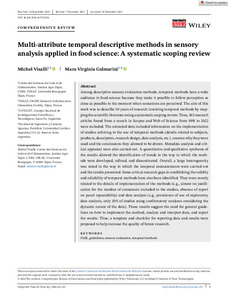Por favor, use este identificador para citar o enlazar este ítem:
https://repositorio.uca.edu.ar/handle/123456789/18328| Título: | Multi-attribute temporal descriptive methods in sensory analysis applied in food science: a systematic scoping review | Autor: | Visalli, Michel Galmarini, Mara Virginia |
Palabras clave: | ALIMENTOS; METODOS TEMPORALES; EVALUACION SENSORIAL | Fecha de publicación: | 2024 | Editorial: | Mary Ellen Camire | Cita: | Visalli, M., Galmarini, M. V. Multi-attribute temporal descriptive methods in sensory analysis applied in food science: a systematic scoping review [en línea]. Comprehensive reviews in food science and food safety. 2024, 23 (1). doi: 10.1111/1541-4337.13294. Disponible en: https://repositorio.uca.edu.ar/handle/123456789/18328 | Resumen: | Abstract: Among descriptive sensory evaluation methods, temporal methods have a wide audience in food science because they make it possible to follow perception as close as possible to the moment when sensations are perceived. The aim of this work was to describe 30 years of research involving temporal methods by map ping the scientific literature using a systematic scoping review. Thus, 363 research articles found from a search in Scopus and Web of Science from 1991 to 2022 were included. The extracted data included information on the implementation of studies referring to the use of temporal methods (details related to subjects, products, descriptors, research design, data analysis, etc.), reasons why they were used and the conclusions they allowed to be drawn. Metadata analysis and crit ical appraisal were also carried out. A quantitative and qualitative synthesis of the results allowed the identification of trends in the way in which the meth ods were developed, refined, and disseminated. Overall, a large heterogeneity was noted in the way in which the temporal measurements were carried out and the results presented. Some critical research gaps in establishing the validity and reliability of temporal methods have also been identified. They were mostly related to the details of implementation of the methods (e.g., almost no justifi cation for the number of consumers included in the studies, absence of report on panel repeatability) and data analysis (e.g., prevalence of use of exploratory data analysis, only 20% of studies using confirmatory analyses considering the dynamic nature of the data). These results suggest the need for general guide lines on how to implement the method, analyze and interpret data, and report the results. Thus, a template and checklist for reporting data and results were proposed to help increase the quality of future research. | URI: | https://repositorio.uca.edu.ar/handle/123456789/18328 | ISSN: | 1541-4337 (online) 1541-4337 (impreso) |
Disciplina: | INGENIERIA EN ALIMENTOS | DOI: | 10.1111/1541-4337.13294 | Derechos: | Acceso abierto | Fuente: | Comprehensive reviews in food science and food safety. 2024, 23 (1). |
| Aparece en las colecciones: | Artículos |
Ficheros en este ítem:
| Fichero | Descripción | Tamaño | Formato | |
|---|---|---|---|---|
| multi-attribute-temporal.pdf | 3,87 MB | Adobe PDF |  Visualizar/Abrir |
Este ítem está sujeto a una Licencia Creative Commons

